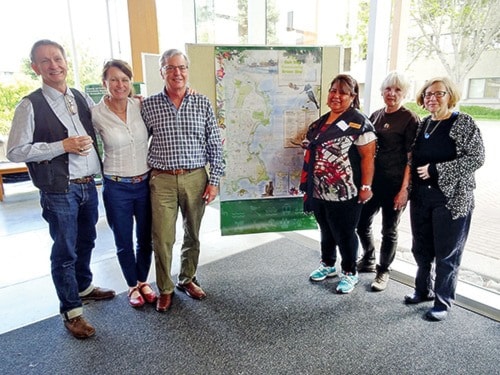Oak Bay’s green map is forging its way as a flagship project locally and around the world.
“The effect of this map continues, which is more than what we expected. We had no real knowledge of the endearing value that people continue to, not only in the community but internationally, speak to it as one of the leading green maps,” said Coun. Tom Croft, who was among the creators of the document. “We kept on having to go to events and ask people to support us so we kept getting more input. There’s a real value to taking your time … you get all of that knowledge of place.”
The green map, already responsible for formulating a community association in Oak Bay, is building on its connections to local First Nations and pride of place. UVic is facilitating connections between communities and university student resources for “concrete action projects” to support the Songhees Nation in cultural restoration work.
“They want to bring back knowledge on traditional fisheries and traditional use,” said Maeve Lydon, associate director of the UVic Institute for Studies and Innovation in Community University Engagement. “Oak Bay as a neighbourhood and as a municipality could be a part of the bigger discussion.”
Lydon’s been part of 15 to 20 green maps across the region in the past 20 years and agrees that Oak Bay’s had a lot of process involved.
The community green map started as an idea germinating in the minds of a couple residents, and is now part of the package Oak Bay Mayor Nils Jensen hands out as he personally welcomes newcomers.
Lydon started working with Oak Bay a decade ago when former councillor Pam Copley approached her. Tom’s wife, Jill Croft, got on board early on, and after a couple years working on the project, it spurred the creation of the Community Association of Oak Bay, which worked another four years on the map before it went to print in 2012.
“It was such a neat project. It has been taken around the world now,” Tom said.
Richly illustrated with vibrant, colourful images and icons, it plots the locations of those things the people of Oak Bay identified as being central to their identities. Bike trails are marked, as are walking trails and great places to play with the family dog. There are the predictable icons that identify public libraries and schools, but there are also icons for mystical places, great places to watch the sunset or sunrise, and wonderful spots to fly a kite or watch the night sky.
The flip-side of the document is also richly illustrated and provides narrative details on the history, heritage, climate and community resources of Oak Bay.
“I’ve lived in Victoria all my life. I navigate by place, I don’t navigate by street corners, so I find it more natural to think about where something is in relation to landmarks,” Croft said. “This is a map of place, of activities, of all the other things you see on maps. Green mapping lends itself to First Nations. The naming they use is related to events and activities.”
It also details aspects of life in Oak Bay that engage or concern the population, including environmental stewardship groups, community resources and emergency preparedness agencies and initiatives.
Lydon organized The Power and Potential of Community Green Mapping in April to bring together academics and a variety of community members, including the Esquimalt and Songhees Nations to explore community-based mapping and green mapping as tools for community engagement.
A feature speaker at the event was Wendy Brawer, creator and director of Green Maps, based in New York.
“Wendy’s taken [the Oak Bay Community Green Map] to Africa … presented it at the United Nations as an example of an asset map,” Croft said. “It’s unbelievable where this map has taken the community association.”
Green mapping began in New York City in the 1990s as a way of connecting tourists, residents and new arrivals to the green spaces and culturally significant locations within New York. The idea caught on and soon grew into a worldwide phenomenon. There are more than 750 interactive on-screen maps in 61 countries.
cvanreeuwyk@oakbaynews.com
